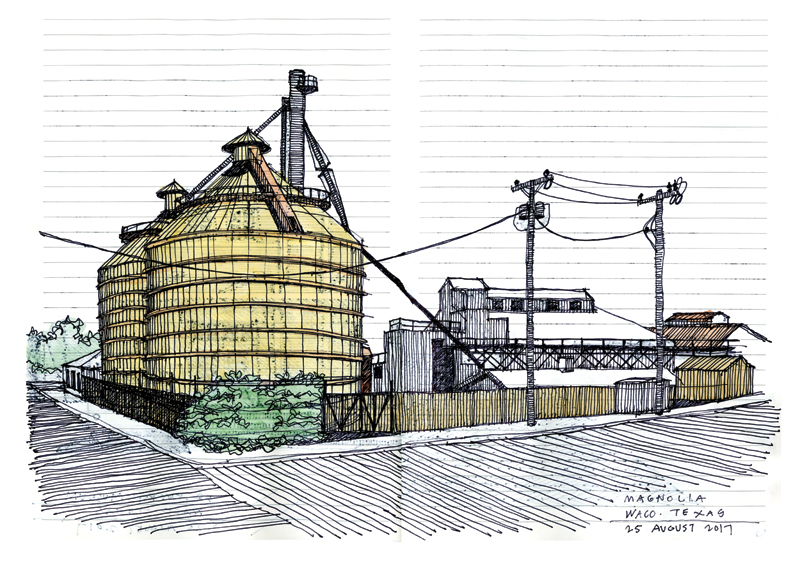Out of the Silos
Traveling the I-35 corridor between Dallas and Austin as I often do, the halfway point milestone is Waco, the city best known as the home of Baylor University. On the three-hour drive, Waco is not quite far enough to require a stop. If I’m hungry, there are kolaches in West, and if I need gas or a restroom, I’ve come to like the convenience of Buc-ee’s in Temple. Over the last several years, Waco’s highway frontage has seen a transformation courtesy of a boom in new construction, the new Baylor McLane football stadium, and a variety of retail and restaurant options. None of them have yet tempted me. Austin is usually my goal, and I can make it there without a stop.
This summer, the Texas Society of Architects hosted the 2017 Prosperity Conference in downtown Waco at the Hippodrome Theater. For attendees like me, it provided an opportunity to get off the highway and actually stop and visit the hitherto unknown downtown. Surprised by the quality of the architectural building stock of this often-underappreciated Texas city, I took time to explore the streets, take note of the buildings, and visit the Dr. Pepper Museum, which is housed in a 1906 Richardsonian building. While there, I noticed some wonderful industrial silos a few blocks away and walked over to look at them. The closer I got, I noticed a crowd of people who seemed to be in the same area, moving toward the silos as a group drawn by something I didn’t recognize or understand.
Of course, these silos were part of the Magnolia Market, mecca for fans of the HGTV show “Fixer Upper” and its Waco-based hosts Chip and Joanna Gaines. Having never watched the show, I did not know who the Gaineses were, nor did I have any familiarity with their many businesses — construction, remodeling, retail — all supporting a firmly established and much-loved brand tied to their warm and buoyant personalities.
The story of the adaptation of the former silos and their adjacent buildings into the Magnolia Market goes something like this: Joanna wants to reopen her store (Magnolia), which had closed several years before, when she was focused on the TV show and her young family. Dropping her children at school, she saw the site — in particular a small building that was part of the larger complex — and thought it would make a good store. Upon further investigation, she realized the silos and granary were also among the buildings, and convinced her husband that they should acquire it all. It could not only host the store, but could become home to their new business headquarters and a retail complex. This expanded vision received the support of the City of Waco, even extending to the development receiving tax increment financing. In 2015, it opened to huge crowds that have persisted over the last two years and have sparked a renaissance of sorts in downtown Waco. Shops, restaurants, and other amenities — all spawned by the success of the Magnolia — have opened within walking distance of the development, most with the same country-funky vibe and the attendant adaptive reuse of older structures. A cursory review shows an emphasis on local artisans, barbeque, and craft beverages, ideal for slaking the hunger and thirst of visitors from out of town.
When they initially contacted the site’s then-owners, the Gaineses discovered that it was a family property held by heirs who’d been reluctant to sell, fearing the silos would be demolished. Earlier inquiries from other interested parties had suggested to the family that would-be buyers wanted to remove the silos. The Gaineses committed to integrating the silos into their project. Remarkable as objects, the silos call to mind the industrial landscape paintings and photographs of artist Charles Sheeler. They embody a kind of assertive industrial optimism no longer associated with American manufacturing, and are an important (but under-noticed) part of the Waco skyline. It’s hard to tell if the Gaineses supported preservation of the silos out of value for their history, or whether they just found them to be cool. Either way, Waco was able to maintain an important part of its history.
As an architect, I was drawn to the site by the silos, but did not expect to encounter the large numbers of people enjoying very public urbanism in the broiling midday sun. The draw may have been the Magnolia Market building and the merchandise available inside, but that did not explain the folks sitting in the outdoor areas in the heat while their children played in the square, itself a remarkable space framed by food trucks, all doing a brisk trade. These visitors were inhabiting and engaging with a well-executed public space with surprising urbanist components, proving the adage “If you build it, they will come.” It was clear to me that they all could have left after a visit to the store, but they were staying on to eat and engage in a public experience of urban life — in Waco! It felt authentic, startlingly real, and I could not help but think it could have been anywhere in Europe, though, aesthetically, it is a much different experience. Successful place-making is hard, and this was a master class for everyone to enjoy.
Magnolia Market’s abundant (and largely effusive) press coverage focuses on the Gaineses and their vision for the facility. Once the adaptive reuse of the granary building has been noted, the silos are relegated to backdrops for the other components: a garden store, a bakery, the food trucks, and the lawn and plaza area. Few press articles remark on or are surprised by the clever use of agricultural/industrial buildings and the other obsolete infrastructure on the site. Other than the silos, there does not seem to be any overt reference to the complex’s former life; it certainly isn’t celebrated. This may be a result of the Gaineses history of remodeling unremarkable houses in search of new lives: To the fans of their show, Magnolia represents a larger but still-successful example of their expertise.
The Magnolia is one of many reclaimed industrial sites that have been successfully repurposed as multiuse developments. The Pearl Brewery in San Antonio is another example. The heart of Magnolia is not the store (which is probably the core of the business operations), but the expansive lawn and its adjacent pulverized granite counterpart. On the day I visited, the lawn was filled with children gleefully running about, kicking soccer balls, and throwing footballs with their parents. None seemed to notice (or mind) the sunshine or the heat. The lawn is defined on its edges by the market building, the silos, a relocated barn, and food trucks and stands. It is public space, with all of the requisite elements for success: shade, food, commerce, site furniture, and play. It is too well done to be accidental, but it’s not clear that any design professional other than the Gaineses had anything to do with the planning. Inhabiting the lawn and adjacent square is possible in a variety of ways. Visitors can sit on benches, on portable chairs, at shaded tables, or on one of the many swings. The barn, a rustic structure relocated from Canada, shelters more traditional picnic tables, painted a tasteful white.
News articles indicate that there was some initial concern that the Gaineses plans to leave the silos unpainted was an issue for some in the City of Waco, but fortunately their sensibilities prevailed, and the silos fulfill the role as marker, clearly delineating the history of the complex and giving the development weight. Published articles indicate that future phases have in mind to make these silos useful once again. Sprouting from the silos are all manner of pipes, ducts, and conduits, once a part of their operational hardware but now just visually interesting sculpture. All rusting, these pipes track throughout the site, a reminder that once the contents of the silos were distributed for shipping and delivery, but now they act as frames and trellis structures. Carefully edited, they serve an aesthetic role, and their presence is oddly grounding and reassuring.
A cynic could poke fun at the Magnolia, calling the Gaineses and their fans middle-brow escapists caught up in a nostalgic fantasy of a simple country life filled with painted shiplap and flowers in repurposed galvanized buckets. It’s a life the American suburbs don’t typically offer, but it’s gaining ground, in no small part due to the Gainses’ success and the visibility of their program. Recent merchant housing design trends promote this theme with concepts like “the modern farmhouse” and “barndominium” — places where the cheery merchandise from Magnolia would definitely find a home. In any case, one cannot ignore the visual and urban success of the overall complex: carefully executed, thoughtfully detailed, and inviting to visit. As an architect, I look for lessons everywhere I go, and though I may never buy more than coffee or lunch at Magnolia, I was glad to stumble on it and delighted to be a participant. Clearly, I was not alone.
Michael Malone, FAIA, is a principal of Malone Maxwell Borson Architects in Dallas.

Michael Malone, FAIA, is the founding principal of Malone Maxwell Dennehy Architects and an adjunct assistant professor of architecture at the University of Texas at Arlington.



